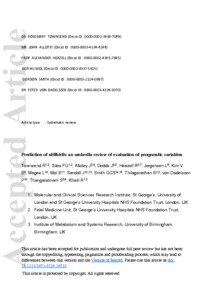Townsend, R;
Sileo, FG;
Allotey, J;
Dodds, J;
Heazell, A;
Jorgensen, L;
Kim, VB;
Magee, L;
Mol, B;
Sandall, J;
et al.
Townsend, R; Sileo, FG; Allotey, J; Dodds, J; Heazell, A; Jorgensen, L; Kim, VB; Magee, L; Mol, B; Sandall, J; Smith, G; Thilaganathan, B; von Dadelszen, P; Thangaratinam, S; Khalil, A
(2021)
Prediction of stillbirth: an umbrella review of evaluation of prognostic variables.
BJOG, 128 (2).
pp. 238-250.
ISSN 1471-0528
https://doi.org/10.1111/1471-0528.16510
SGUL Authors: Khalil, Asma
![[img]](https://openaccess.sgul.ac.uk/112433/1.hassmallThumbnailVersion/1471-0528.16510.pdf)  Preview |
|
PDF
Accepted Version
Available under License ["licenses_description_publisher" not defined].
Download (1MB)
| Preview
|
Abstract
BACKGROUND: Stillbirth accounts for over 2 million deaths a year worldwide, and rates remains stubbornly high. Multivariable prediction models may be key to individualised monitoring, intervention or early birth in pregnancy to prevent stillbirth. OBJECTIVES: To collate and evaluate systematic reviews of factors associated with stillbirth in order to identify variables relevant to prediction model development. SEARCH STRATEGY: Medline, Embase, DARE and Cochrane Library databases and reference lists were searched up to November 2019. SELECTION CRITERIA: We included systematic reviews of association of individual variables with stillbirth without language restriction. DATA COLLECTION AND ANALYSIS: Abstract screening and data extraction were conducted in duplicate. Methodological quality was assessed using AMSTAR and QUIPS criteria. The evidence supporting association with each variable was graded. RESULTS: The search identified 1198 citations. 69 systematic reviews reporting 64 variables were included. The most frequently reported were maternal age (n=5), BMI (n=6) and maternal diabetes (n=5). Uterine artery Doppler appeared to have the best performance of any single test for stillbirth. The strongest evidence of association was for nulliparity and pre-existing hypertension. CONCLUSION: We have identified variables relevant to the development of prediction models for stillbirth. Age, parity and prior adverse pregnancy outcomes had a more convincing association than the best performing tests which were PAPP-A, PlGF and UtAD. The evidence was limited by high heterogeneity and lack of data on intervention bias.
| Item Type: |
Article
|
| Additional Information: |
This is the peer reviewed version of the following article: Townsend, R, Sileo, FG, Allotey, J, Dodds, J, Heazell, A, Jorgensen, L, Kim, VB, Magee, L, Mol, B, Sandall, J, Smith, GCS, Thilaganathan, B, von Dadelszen, P, Thangaratinam, S, Khalil, A. Prediction of stillbirth: an umbrella review of evaluation of prognostic variables. BJOG: Int J Obstet Gy. 2021; 128: 238– 250, which has been published in final form at https://doi.org/10.1111/1471-0528.16510. This article may be used for non-commercial purposes in accordance with Wiley Terms and Conditions for Use of Self-Archived Versions. |
| Keywords: |
Systematic reviews, epidemiology: perinatal, fetal medicine: perinatal diagnosis, fetal medicine: serum screening, ultrasound, Obstetrics & Reproductive Medicine, 11 Medical and Health Sciences |
| SGUL Research Institute / Research Centre: |
Academic Structure > Molecular and Clinical Sciences Research Institute (MCS) |
| Journal or Publication Title: |
BJOG |
| ISSN: |
1471-0528 |
| Language: |
eng |
| Dates: |
| Date | Event |
|---|
| 3 January 2021 | Published | | 13 October 2020 | Published Online | | 17 August 2020 | Accepted |
|
| Publisher License: |
Publisher's own licence |
| PubMed ID: |
32931648 |
 |
Go to PubMed abstract |
| URI: |
https://openaccess.sgul.ac.uk/id/eprint/112433 |
| Publisher's version: |
https://doi.org/10.1111/1471-0528.16510 |
Statistics
Item downloaded times since 29 Sep 2020.
Actions (login required)
 |
Edit Item |



